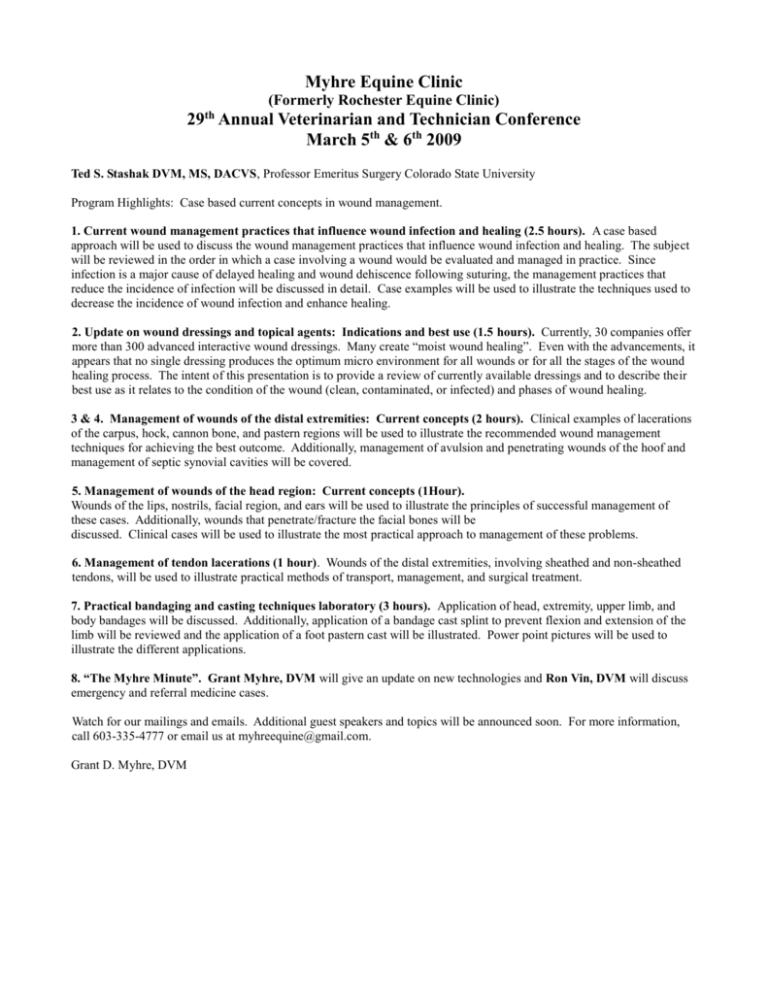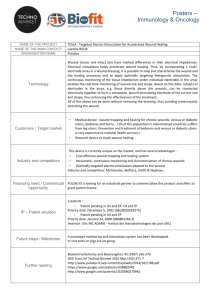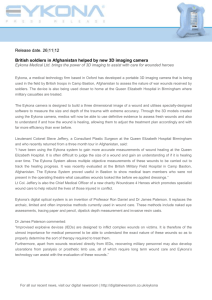2009_VetTech_Confere..
advertisement

Myhre Equine Clinic (Formerly Rochester Equine Clinic) 29th Annual Veterinarian and Technician Conference March 5th & 6th 2009 Ted S. Stashak DVM, MS, DACVS, Professor Emeritus Surgery Colorado State University Program Highlights: Case based current concepts in wound management. 1. Current wound management practices that influence wound infection and healing (2.5 hours). A case based approach will be used to discuss the wound management practices that influence wound infection and healing. The subject will be reviewed in the order in which a case involving a wound would be evaluated and managed in practice. Since infection is a major cause of delayed healing and wound dehiscence following suturing, the management practices that reduce the incidence of infection will be discussed in detail. Case examples will be used to illustrate the techniques used to decrease the incidence of wound infection and enhance healing. 2. Update on wound dressings and topical agents: Indications and best use (1.5 hours). Currently, 30 companies offer more than 300 advanced interactive wound dressings. Many create “moist wound healing”. Even with the advancements, it appears that no single dressing produces the optimum micro environment for all wounds or for all the stages of the wound healing process. The intent of this presentation is to provide a review of currently available dressings and to describe their best use as it relates to the condition of the wound (clean, contaminated, or infected) and phases of wound healing. 3 & 4. Management of wounds of the distal extremities: Current concepts (2 hours). Clinical examples of lacerations of the carpus, hock, cannon bone, and pastern regions will be used to illustrate the recommended wound management techniques for achieving the best outcome. Additionally, management of avulsion and penetrating wounds of the hoof and management of septic synovial cavities will be covered. 5. Management of wounds of the head region: Current concepts (1Hour). Wounds of the lips, nostrils, facial region, and ears will be used to illustrate the principles of successful management of these cases. Additionally, wounds that penetrate/fracture the facial bones will be discussed. Clinical cases will be used to illustrate the most practical approach to management of these problems. 6. Management of tendon lacerations (1 hour). Wounds of the distal extremities, involving sheathed and non-sheathed tendons, will be used to illustrate practical methods of transport, management, and surgical treatment. 7. Practical bandaging and casting techniques laboratory (3 hours). Application of head, extremity, upper limb, and body bandages will be discussed. Additionally, application of a bandage cast splint to prevent flexion and extension of the limb will be reviewed and the application of a foot pastern cast will be illustrated. Power point pictures will be used to illustrate the different applications. 8. “The Myhre Minute”. Grant Myhre, DVM will give an update on new technologies and Ron Vin, DVM will discuss emergency and referral medicine cases. Watch for our mailings and emails. Additional guest speakers and topics will be announced soon. For more information, call 603-335-4777 or email us at myhreequine@gmail.com. Grant D. Myhre, DVM






